Back to: Table of Contents | Chapter 3. The War Years
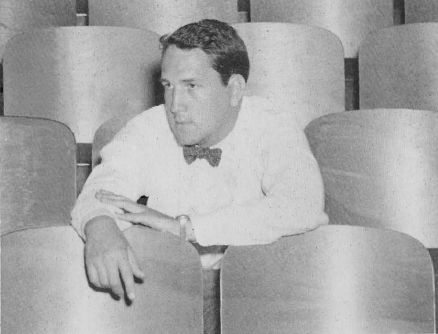
Ainslie Pryor, Director-Manager of Raleigh Little Theatre, 1947-1953
In his directing debut at the Raleigh Little Theatre, Ainslie Pryor had a natural publicity vehicle in the production of “Dream Girl.” He conducted a search for — what else? — a “dream girl” to play the lead. The local press cooperated and the result was aRaleigh version of the Hollywood hype that accompanied worldwide searches for actresses to play the leads in films like “Gone With the Wind” and “The Song of Bernadette.” Pictures of the 25 aspirants for the RLT role appeared in the Raleigh newspapers amid speculation as to who would be chosen. The coveted role went to Mary Alice Spivey (later Mrs. Robert Tucker) and “Dream Girl” was presented October 6-13, 1947. The News and Observer critic liked the show:

From “Dream Girls” (1947-1948)
“It was evident that the play had lost none of its sparkle and wit in the transition from Broadway’s Coronet Theatre to Raleigh’s progressive Little Theatre on Pogue Street.
“…Special commendation goes to Ainslie Pryor, new director-manager of the Little Theatre, who not only did a splendid job of directing his first production here but also managed to take over the leading male role after Howard Maschmeier was unable to continue in the part. As Clark Redfield, Pryor is a standout. Deftly he avoids playing the newspaperman as just another free-thinking conceited ass.”
RLT followed up with “Years Ago,” based on the life of actress Ruth Gordon, winning praise from The N&O critic who found it “a finished, professional production that is easy to watch and fun to chuckle with.” The play ran November 17-23, 1947.
“The Glass Menagerie” — presented January 19-24, 1948 — starred Baker Wynne, Elizabeth Cannon, Saravette Royster and Gil Bullard. The Raleigh Times said that “while accolades could be showered upon each member [of the cast] in great profusion, there is, in this case as in most, a standout — Saravette Royster.”
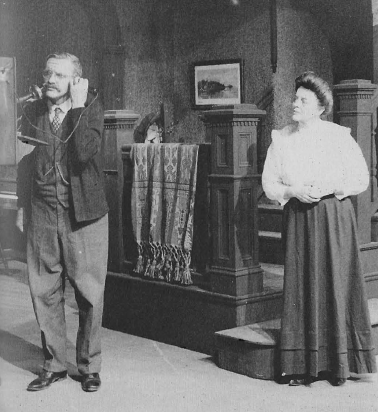
From “Dream Girls” (1947-1948)
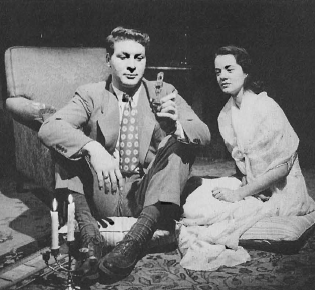
Saravette Royster with Gil Bullard in “The Glass Menagerie” (1948)
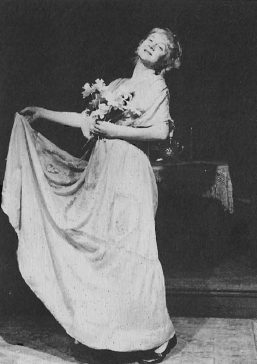
Elizabeth Cannon as Amanda in “The Glass Menagerie” (1947-48)
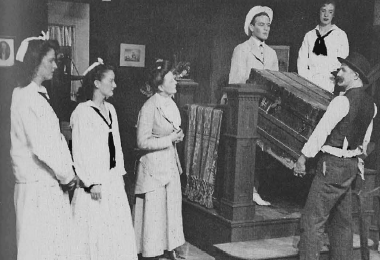
From “Years Ago” (1947-1948)
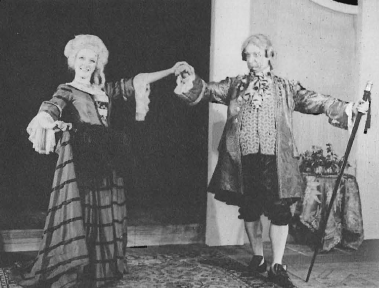
Frances Green and Clifton Beckwith in “The Rivals” (1947-1948)
“The Rivals” by Richard Sheridan (March 1-6, 1948) drew special praise for Clifton Beckwith in a leading role, but a lukewarm reception for the play itself from The Times’ reviewer: “It is not a play which would be greatly popular with modern-day audiences. However, as presented by the Little Theatre Sunday, the 18th-century comedy offered a pleasant way to pass two hours.”
“Philadelphia Story” (April 12-17, 1948) prompted The Times to comment that the “Little Theatre is ending its winter season in grand style with one of its most successful productions to date.” The cast included Lorena Gaddy Goodwin, Andy Goodwin, Dorothy Connolly, Harry Dorsett and Ainslie Pryor, who also directed.
Raleigh Jaycees joined with RLT in sponsoring a May production of “On Borrowed Time” in the amphitheatre, and The News and Observer critic said it was “chockfull of laughs and tenderness.” A feature story in The N&O gave a glimpse backstage, describing how technical director Bill Long had constructed an artificial tree for key scenes in the drama, building an armature of two-by-four lumber, covering it with chicken wire and strips of canvas, then decorating it with 5,000 leaves which the set crew had cut out of cloth, painted green and attached by individual wires to the branches. The story added: “Long made only one concession to nature in building the tree. He used real apples. The apples, four dozen of them to be exact, were wired to the branches to give the final touch of realism.”
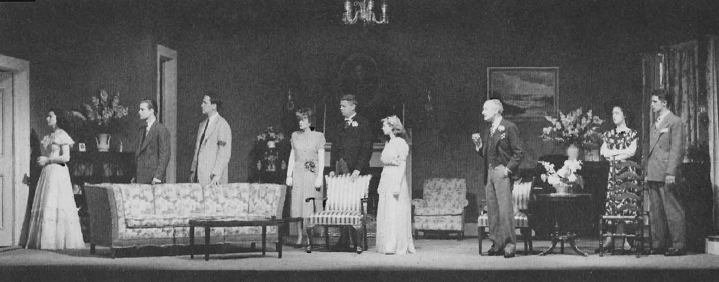
The cast of “Philadelphia Story” (1947-1948)
The 1948-49 season opened with RLT’s first production of the comedy classic “Life With Father.” Besides directing the play, said The N&O, Pryor “plays the efficient but explosive Father in a manner that will reassure all males who believe ‘we men have to run the world’ but wonder if this mastery also includes women. Edith Burgess is charming and convincing as the perplexed, completely feminine Mother.” Although competing with the State Fair, “Life With Father” played to full houses the last three nights of its six-night run in October 1948.
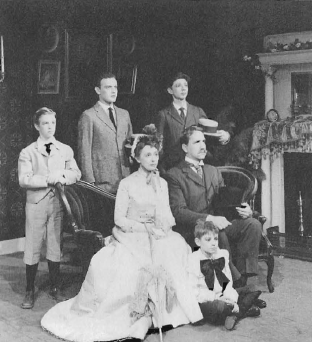
A family portrait from “Life With Father” (1948)
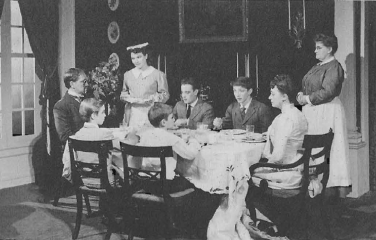
At the table in “Life With Father” (1948) are: (clockwise) Ainslie Pryor, Frances O’Neal, Leonard Mann, Alan Gordon, Emily Purcell (standing), Edith Burgess, Jackie Mobley and Ned Meekins
November 30 through December 4, an original farce by Jack Kelly, “The Lady Has Ideas” was given a pre-Broadway showing at RLT. The Young Business Men’s Club bought out the entire first night, and The N&O said the play was “attractively staged, adequately directed, and played right merrily.”
The Raleigh Times reviewer also made a point about presenting original scripts: “In the opinion of this reviewer, this experiment by the Little Theatre is one which should be repeated once every season. Not only does it give local acting talent an opportunity to gain experience in a new play, but it gives prospective playwrights a chance to show what they can do.”
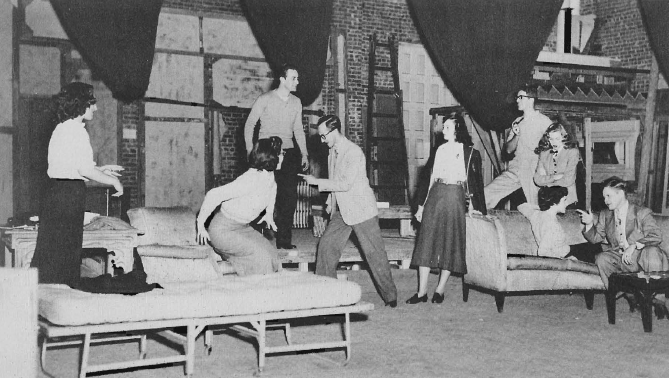
Scene from “The Lady Has Ideas” (1948-1949)
RLT received more national publicity with a three-page spread in the February 1949 issue of Better Health magazine, which cited the theatre as “outstanding in the South in its physical growth and in service which it performs for the community.”
In early March, the Little Theatre introduced a Drama Institute, a series of informal discussions of theatre at which members of the audience addressed questions to guest speakers.
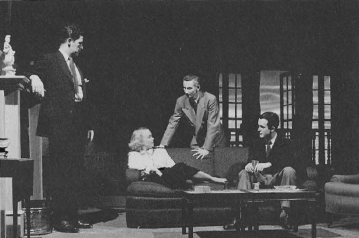
A scene from “Laura” (1948-1949)

A scene from “Laura” (1948-1949)
George Bernard Shaw’s “Pygmalion” played March 7-12, 1949, with Ted Jackson as Professor Higgins and Diana Maupin as Eliza Doolittle. Said The N&O: “Director Ainslie Pryor and everyone who had a hand in ‘Pygmalion’ are to be congratulated. The irascible old G.B.S. himself probably would be pleased with their effort, and Raleigh audiences are certain to find it a good evening’s entertainment.”
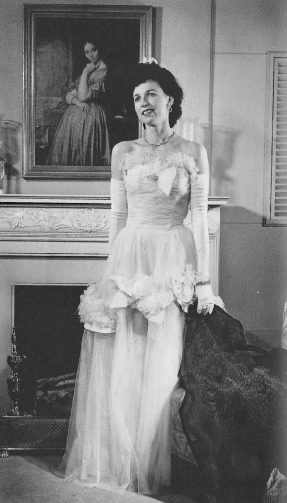
Diana Maupin in “Pygmalion” (1949)
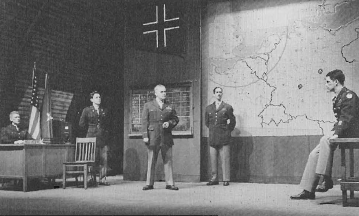
Jimmy Thiem takes center stage in “Command Decision” (1948-1949)
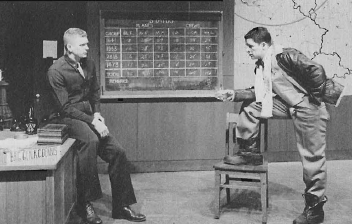
A scene from “Command Decision” (1948-1949)
An April production of “Command Decision” won praise from Bill Armstrong of The Raleigh Times because “the difficult task of putting across convincingly William Wiser Haines’ tension-packed drama … was carried out with notable success by the Raleigh Little Theatre all-male cast.”
For the second consecutive year, Theatre Arts magazine, in its August 1949 issue, featured RLT, with a photograph of the production of “Command Decision.”
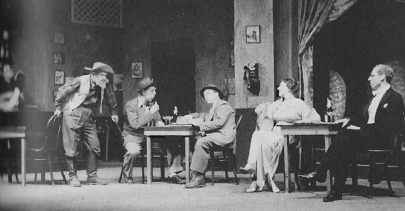
Cantey Sutton enjoys a moment during “Time Of Your Life” (1949-1950)
The 1949-50 season opened September 6, 1949, with a weeklong membership drive. Thiem’s Record Shop — operated by Jimmy Thiem, veteran RLT member-actor and producer of the popular Starlight Concerts series — was headquarters for the drive, and 921 adult members, 335 students and 85 patrons were signed up. The previous year there had been 700 adult members, 360 students and 60 patrons.
The season opener, William Saroyan’s exuberant tribute to humanity, “Time of Your Life,” won raves from The Raleigh Times: “The cast has caught the spirit of Saroyan’s play and gives it a real vitality, seldom seen in amateur companies with such a large cast. Special praise must go both to Ainslie Pryor for his direction and to the members of the production staff who have somehow managed to move Nick’s Saloon, Restaurant and Entertainment Palace intact from the waterfront without breaking a glass.” Leading roles were played by Baker Wynne as Joe, Pryor as Nick, Ted Jackson as Tom, Bill Alspaugh as Kit Carson, Jacquelyn Natale as Kitty Duval, and Cantey Sutton as a Society Lady.
In November 1949, a Players’ Club was organized, open to persons who had appeared in a certain number of roles at RLT. Plans were discussed to hold an annual costume ball for members and their friends.
RLT’s December 1949 production of “Two Blind Mice” was one of the first non-professional performances of the comedy in the nation. Mary Long and Nancy Stamey took leading roles.
The classics again took the spotlight January 30 through February 4, 1950, with production of Robinson Jeffers’ free adaptation of Euripides’ tragedy “Medea.” Speaking of Vera Simpson’s performance in the title role, The N&O commented: “She is outstanding … Her performance is consistent and excellent.”
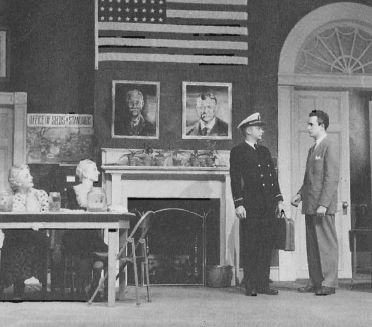
Scene from “Two Blind Mice” (1949-1950)
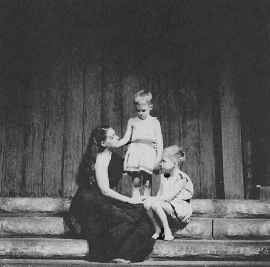
A dramatic moment from “Medea” (1949-1950)
The first annual Melody Ball was held February 17, 1950, at the Carolina Country Club, sponsored by the Players’ Club. Guests wore costumes portraying song titles, and the proceeds were used to buy equipment for the theatre.
RLT joined in observing International Theatre Month in March 1950 with a production of the comedy-drama “The Hasty Heart,” a production that had “pathos and humor” and was “performed admirably,” according to Charles Craven, writing in The News and Observer.
On Easter Sunday, April 9, 1950, the Little Theatre joined with the Knights Templar in presenting an Easter pageant in the amphitheatre, depicting the crucifixion and resurrection of Christ.
The 1949-50 season closed with the first off-Broadway production of “Born Yesterday,” the comedy hit. Ainslie Pryor and Ann Dearing took the leads. Mary Long was co-director with Pryor.
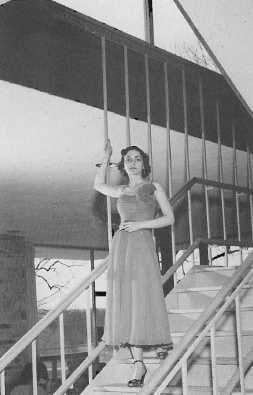
Ann Dearing in a publicity photo for “Born Yesterday” (1949-1950)
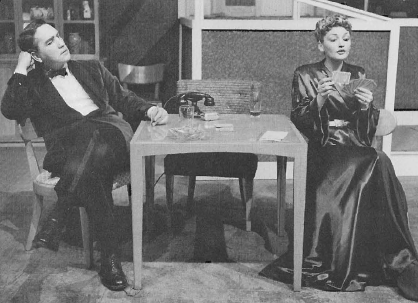
Ann Dearing with Ainslie Pryor in “Born Yesterday” (1949-1950)
A bonus production in the amphitheatre featured Vera Simpson as Kate and Joe Reeves as Petruchio in “The Taming of the Shrew.”
The Little Theatre presented its first “Oscars” for outstanding performances at the annual membership meeting May 23, 1950. The winners were Vera Simpson, best actress, “Medea”; Paul Hoover for the role of Yank in “The Hasty Heart,” best actor; Saravette Royster (“The Hasty Heart”) and James Thiem (“Born Yesterday”), best performances in supporting roles; and Joe Edwards and Jackie Natale, best newcomers. A special plaque was presented to Gene Neal for his work as lighting technician.
For the third straight year, Theatre Arts magazine paid tribute to RLT, carrying a photo of “Time of Your Life” in its “Theatre: USA” series.
The 1950-51 season was loaded with first-rate theatre, enough top-quality plays to make present-day theatre lovers yearn for the good old days.
The season opener was “Light Up the Sky,” with 10 of the 13 roles filled by newcomers to RLT in a show that was called “bright and laughter-filled” by The Raleigh Times.
The Anita Loos comedy “Happy Birthday” followed in December. Saravette Royster and Joe Reeves had the leads and Roy Wilder Jr. wrote in The N&O that the play was “a warming and welcome Christmas gift.”
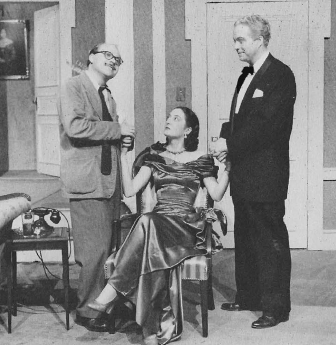
Plotting theatrical hi-jinks in “Light Up The Sky” (1950-1951)
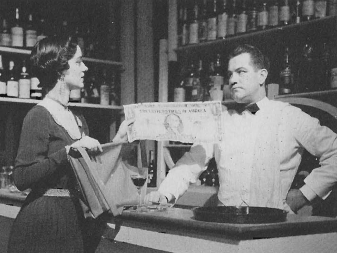
Inflation hits the props in “Happy Birthday” (1950-1951)
“Detective Story,” presented in February 1951, starred Pryor and Betty Lokey and was staged “with skill and ingenuity,” according to The Raleigh Times.
Yet another heavyweight drama, “The Madwoman of Chaillot,” followed in March 1951, with Marguerite Barton, a native of England, in the title role. The N&O’s reviewer said the play “flowed with remarkable smoothness.”
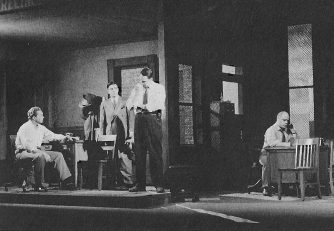
Men at work in the “Detective Story” (1950-1951)
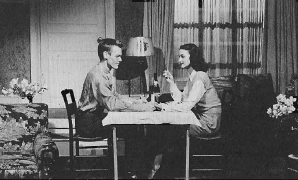
From “Voice Of The Turtle” (1950-1951)
John Van Druten’s modern classic, “Voice of the Turtle,” was the offering in April 1951 with the cast consisting of Barbara Marshall, Jane Hendricks and Bob Swain.
In May, RLT presented “Mountain Ivy” by Anne Armstrong. The play had been chosen winner of RLT’s first playwrighting contest and was an adaptation of Mrs. Armstrong’s novel, “This Day and Time.” Mrs. Armstrong was awarded a $100 prize on the first night of the play.
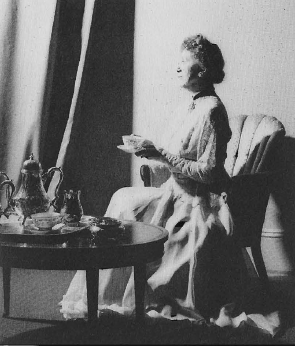
From “The Madwoman Of Chaillot” (1950-1951)
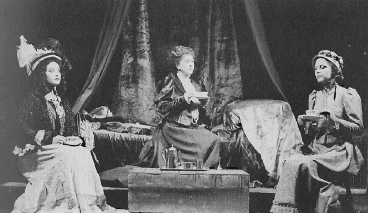
rom “The Madwoman Of Chaillot” (1950-1951)
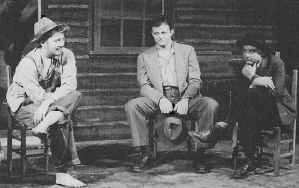
Scene from “Mountain Ivy” (1950-1951)
Also in May, the Raleigh Rose Garden adjacent to the Little Theatre was formally dedicated with Mayor P.D. Snipes accepting the garden for the city.
Raleigh Little Theatre opened its 1951-52 season with an ambitious production — Arthur Koestler’s powerful anti-Communist drama “Darkness at Noon.” Raymond Lowery, veteran entertainment writer for The News and Observer, said of Ainslie Pryor’s direction: “He has, with the help of scene designer William I. Long, mounted it ingeniously, and he has directed it with high skill. What results is a stimulating evening in the theatre.”
“Harvey,” the play about the invisible, 6-foot, 1½-inch rabbit, captured the hearts of Little Theatre audiences November 26 through December 1, 1951, with Nancy Stamey, Paul Hoover, Ruth Green, Coline Covington and Pryor in leading roles.
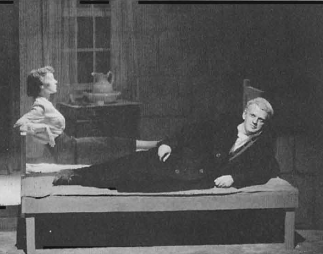
A scene from “Darkness At Noon” (1951-1952)
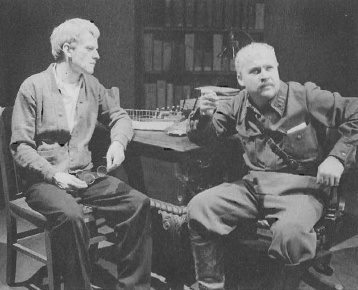
A scene from “Darkness At Noon” (1951-1952)
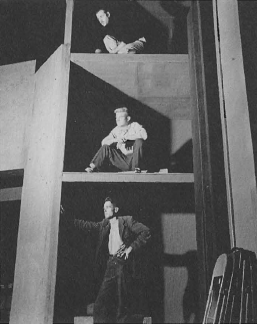
Stylized prison set in “Darkness At Noon” (1951-1952)
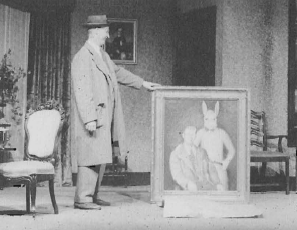
Paul Hoover and friend in “Harvey” (1951-1952)
In “The Two Mrs. Carrolls,” a mystery thriller that played January 29 through February 3, 1952, Diana Maupin “pulls out all the stops in playing Sally Carroll and that means there is plenty of emotion exploding at the Little Theatre this week.”
RLT’s play selection committee decided to let the audience vote on which play to do next — a first production of Shaw’s “Major Barbara” or a revival of “The Man Who Came to Dinner,” first done in 1942. The classics lost and comedy won with ‘The Man Who Came to Dinner” opening March 16, 1952. “An evening of hilarity,” said The Times.
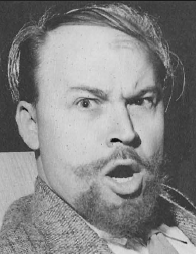
Bill Alspaugh, “The Man Who Came To Dinner” (1951-1952)
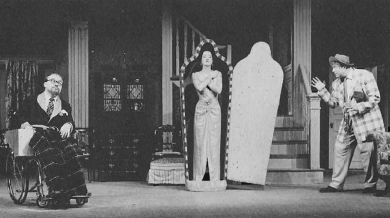
Left to right: Bill Alspaugh, Jane Hendricks (in the mummy case). and Rick Jackson in “The Man Who Came To Dinner” (1951-1952)
On April 13, 1952, the Sunrise Easter Pageant was presented again in the amphitheatre with Pryor acting as reader for the pantomime performance.
“The Front Page” debuted April 29 with a cast of 22, of whom half were making their first appearances on stage. Marjorie Ragan, writing in The News and Observer, said: “Bill Long’s realistic set of a police press room is excellent. It is one of his last sets for the Little Theatre before he goes to the UNC drama department, and the program, made up as an ‘Old Reliable’ front page, pays tribute to his five years with the Little Theatre.”
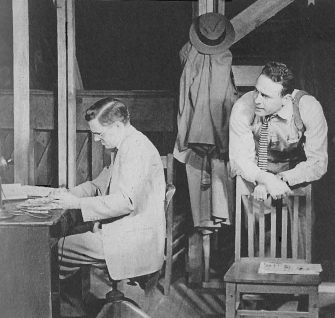
Bill Law (left) and unidentified actor in “The Front Page” (1951-1952)
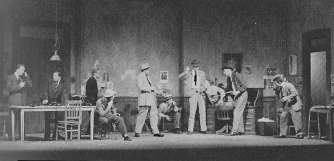
Comic madness in the city hall press room of “The Front Page” (1951-1952)
RLT closed the season with a bonus production, a revival of the Little Theatre’s first play, “The Drunkard,” and it had an out-of-town tryout, a special performance at the NC Pharmaceutical Society convention May 21, 1952, in Pinehurst.
The production also was noteworthy because of a young man who did a vaudeville turn between acts. It was a comedy sketch called “The Preacher and the Bear,” and the young man was best known at the time for his portrayal of Sir Walter Raleigh in “The Lost Colony,” but later was a bit better known as a sheriff in a little town called Mayberry. The young man was, of course, actor Andy Griffith.
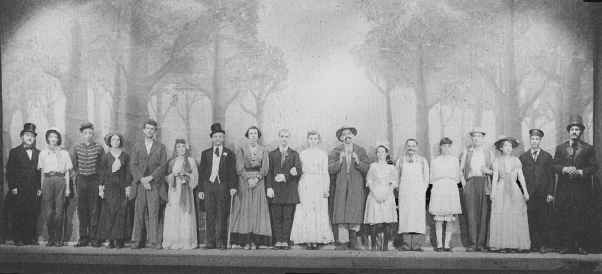
Cast from “The Drunkard” (1951-1952) featuring Andy Griffith fifth from the left. Click the image for a larger version
Gov. Kerr Scott, Sen. Clyde Hoey and other dignitaries showed up for the annual awards night and saw “Darkness at Noon” chosen as best play and top acting awards go to Frank Groseclose and Nancy Stamey.
It was also announced at the annual meeting that Richard Snavely of Chapel Hill had been employed as the new technical director. He was later to serve a record 11 seasons as RLT’s director.
“The Happy Time” opened the 1952-53 season, with The N&O calling it a “delightful and happy evening’s entertainment.” “Remains to Be Seen” in December introduced two newcomers, Pat Hall and Harry Bates, in leading roles.
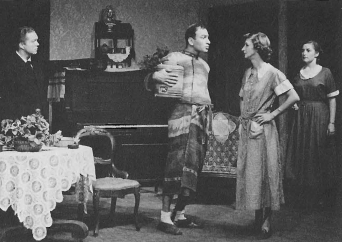
Betty Dick in scene from “The Happy Time” (1952-1953)
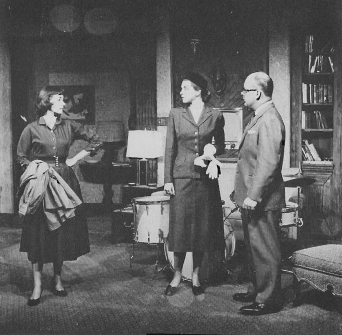
A scene from “Remains To Be Seen” (1952-1953)
The January production of “The Little Foxes” had N.C. State student Diana Stallings, James Thiem, John Faulk and Cantey Sutton in lead roles.
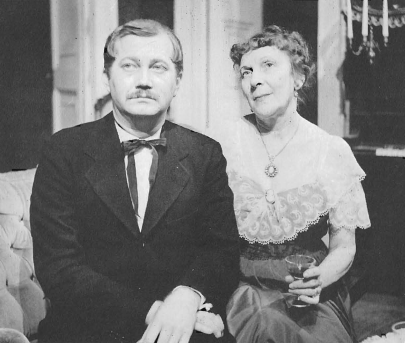
Cantey Sutton with unidentified actor in “The Little Foxes” (1952-1953)
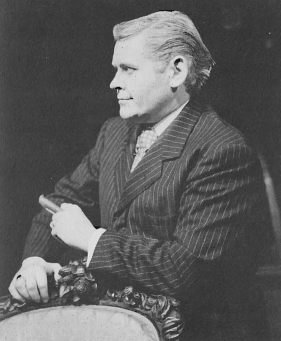
Jimmy Thiem in “The Little Foxes” (1952-1953)
On February 18, 1953, Raleigh attorney R. Mayne Albright presented a proposed lease agreement to the City Council’s Public Works and Planning Committee. It called for lease of the theatre building and amphitheatre to RLT for $1 a year and allowed the Little Theatre to keep for its own use any money raised through sale of tickets or concessions.
In March 1953, RLT offered its audiences “An Evening of Shaw” — “Androcles and the Lion” and “Don Juan in Hell.”
“Mister Roberts,” presented April 16-25, 1953, featured Dan Harvat and Charles Gaddy and won a rave from Bette Elliot of The Raleigh Times:
“The Raleigh Little Theatre’s smash hit of all time. A solid gold Oscar for every person connected with the event.”
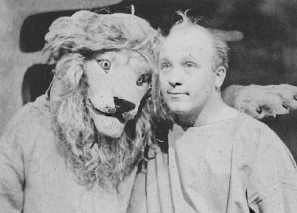
From “Androcles And The Lion” (1952-1953)
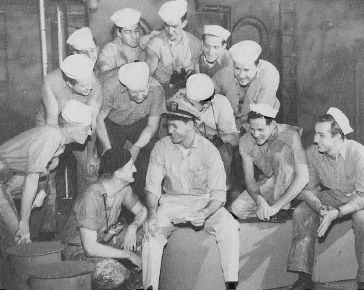
A naval conference in “Mr. Roberts” (1952-1953)
Because of the enthusiasm over its production of “The Drunkard” the previous year, RLT decided to present “Ten Nights in a Barroom” as its bonus production May 20-23. It was not a good idea.
Said Bette Elliot of The Times: “Two hours of archaic dialogue, missed cues, mysterious hands, dangling sandbags, sailors from the last production, ‘Mr. Roberts,’ transposed scenes, angels from heaven, and such, can prove pretty wearing especially since we saw it all last year and it was better then.”
There was, however, a saving grace, one Andy Griffith, who gave a between-the acts rendition of his now famous “What It Was, Was Football” and “Romeo and Juliet” and was, according to Ms. Elliot, “worth the price of admission alone … fabulously funny … could have held the stage all night and no one would have minded.”
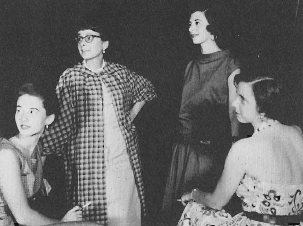
Barbara Mitchell (far left) and friends in “Susan and God” (1953)
Ainslie Pryor, director of the Little Theatre for six years, resigned effective May 31, 1953, to enter professional television and movie production. From then until his untimely death in 1958, Pryor appeared in numerous TV and film roles and as Prosecuting Attorney Challee in the Broadway production of “The Caine Mutiny Court Martial.”
During his time at RLT, Pryor wrote a regular column for The News and Observer called “North Carolina Theatre.” One of the columns, which appeared April 27, 1952, contains some observations that help explain why he is remembered with such affection by RLT veterans. The column described the transformation from novice actor to seasoned performer in one short month of rehearsals and concluded:
“Just before curtain on opening night his old fears return and he wonders what would happen if he just bolted. Maybe he could feign an attack of appendicitis … His uncomfortable reverie is broken when the stage manager calls him for his entrance and before he knows it he’s on stage and everything is all right. Some of the applause at the final curtain belongs to him; that’s the pay-off. And we hope that the folks at home absorb some of that smile that meets them at the door when he comes home.
“The most important thing of all, however, is the fact that he has brought pleasure to a great many people. And, too, he’s become an actor. He might still have two left feet but we love him.”
Raleigh Little Theatre felt that way about Ainslie Pryor.
Pryor’s successor as RLT director was J. David Bowen of Chicago and New York, a 1951 cum laude graduate of Harvard who had worked with the Brattle Theater Company of Boston, the Harvard Theatre Workshop and theatres in Clarksburg, West Virginia, and Antioch, Ohio.
During the summer of 1953, RLT tried something new, an arena presentation of “Susan and God” on the grassy stage of the amphitheatre. The play was held over for a fourth night because of capacity crowds.
RLT opened its 1953-54 season October 23-29, 1953, with a production of “The Petrified Forest” with Dr. Frederick Jonson, Barbara Da Silva and Charlie Mitchell in leading roles, “The smooth-as-silk doings on the Raleigh Little Theatre stage were duly appreciated,” said The Raleigh Times.
Betty Skelton, an internationally famous aerobatic flier, was chosen to play the lead in “Bell, Book and Candle,” December 4-10, 1953, with Bill Trotman and Bill Alspaugh in other leading roles.
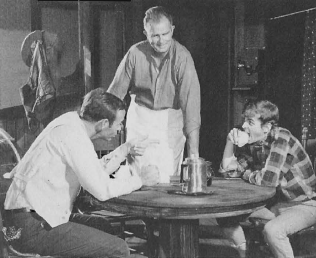
Left to right: Harvey Bumgardner, Howard Massey and Harry Callahan in “The Petrified Forest” (1953-1954)
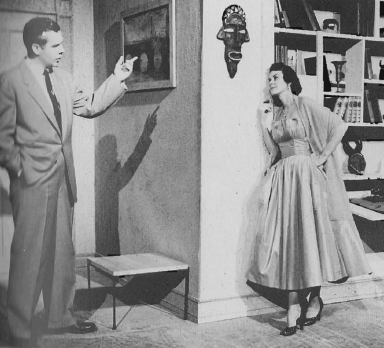
From “Bell, Book and Candle” (1953-1954)
After a January trip to Richmond, Virginia, to see Ainslie Pryor in a touring production of “The Caine Mutiny Court Martial,” RLT members presented “The Country Girl” in January 1954, with leads taken by Betty Lokey and John Bonitz, a Carolina Playmaker.
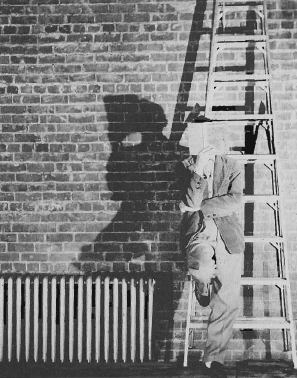
Actor with a passion for anonymity in “The Country Girl” (1954)
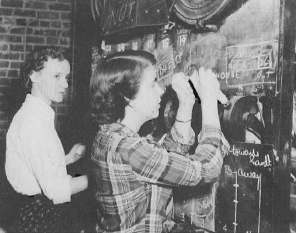
Working lights for “The Country Girl” (1954)
“Boy Meets Girl” (March 9-14, 1954) starred Charles Kahn, James Thiem, John Fox, Ed Wagner and Dick Snavely.
A “Star Ball” April 29, 1954, at the Carolina Country Club highlighted the spring season and raised money for lighting equipment. Cantey Sutton was the sponsor.
Christopher Fry’s adaptation of Jean Anouih’s “Ring Round the Moon” (April 20-25, 1954) drew gloomy reviews. Jim Rankin of The N&O wrote: “The stage was loaded with talent. It seems a pity, though, that the talent wasn’t loaded on a better vehicle.”
The bonus show of the season May 20-22 was “Dracula,” featuring Marcus Hawkins, formerly of the Charlotte Little Theatre. The production abounded in gimmicks — popcorn on sale in the balcony, nurses on duty in the lobby (to care for those who might swoon in terror), an unusual geometric set with distorted windows and doors, and a final performance at midnight Saturday.
An expanded summer program presented three plays arena-style in the amphitheatre — “My Three Angels,” “Summer and Smoke” and “The Philadelphia Story” — all directed by Dick Snavely.
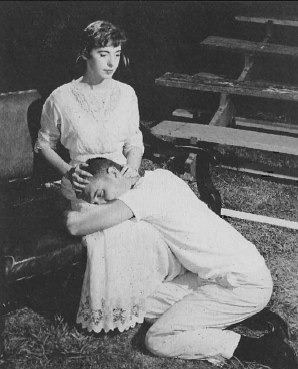
Scene from “Summer And Smoke” (1953-1954)
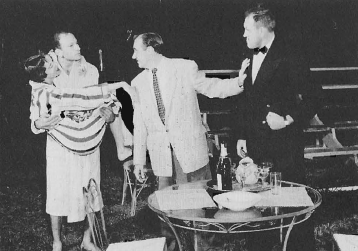
“The Philadelphia Story” (1953-1954) arena-style in the amphitheatre.
The season opener for 1954-55 was the racy comedy “The Moon Is Blue,” featuring Pat Hall, Dr. Fred Jenson, Harry Bates and Jules Medwin. “An infectious little sparkle all its own,” said Bette Elliot of The Times.
“Stalag 17” (December 3-9) offered a look at a World War II prisoner of war camp with an all-male cast of 20, “One of the most arresting productions seen here in some time,” said The Times.
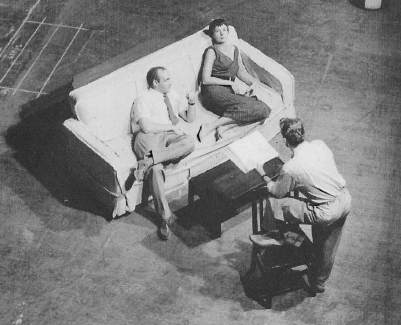
In rehearsal for “The Moon Is Blue” (1954-1955)
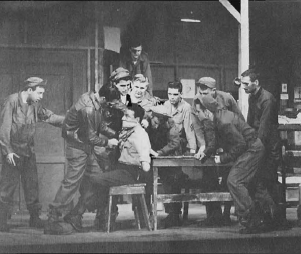
A scene from “Stalag 17” (1954-1955)
“Point of No Return” marked a milestone for the Raleigh Little Theatre when it opened January 28, 1955, It was RLT’s 100th production.
Jane Hall of The News and Observer reported: “Despite the unexpected snow, patrons — including Mrs. Hodges (wife of Gov. Luther H. Hodges) and many of the leading members of the General Assembly — turned out for the preview of the Little Theatre’s 100th play…
“With this 100th play, our hats are off to the Raleigh Little Theatre which for nearly 20 years has been a source of excellent entertainment for Raleigh citizens.” Bette Elliot of The Times, however, had reservations and called the production “wobbly,” adding, “The more discriminating playgoer will be annoyed at the snail’s pace of this current production, but it just might be overshadowed by its excellent technical treatment.”
The 101st production (March 18-25, 1955) was “Climate of Fear,” an original play by Raleigh attorney Charles Aycock Poe about the then current anti-Communist hysteria. Bette Elliot of The Times called it “a smash hit.”
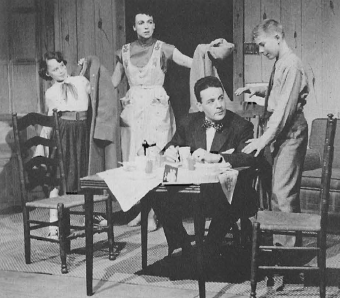
RLT’s 100th production, “Point Of No Return” (1954-1955)
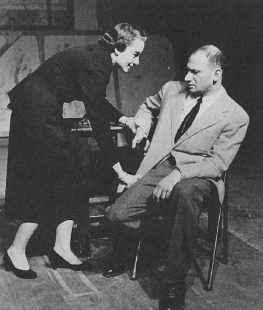
Original work by Charles A. Poe, “Climate Of Fear” (1954-1955)
RLT made its television debut April 10, 1955, on WUNC-TV with “Speak to Him,” an Easter story mainly concerned with the two thieves crucified with Jesus.
“Admirable Crichton” (May 5-12) closed out the season with Fred Jensen in the title role.
On May 31, 1955, J. David Bowen resigned as director-manager to return to professional theatre, and Richard F. Snavely, who had been technical director for three seasons, was named to succeed him.
It was the beginning of a long period of stability and steady growth for the Raleigh Little Theatre.